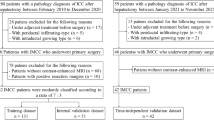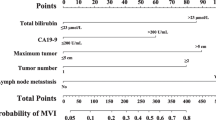Abstract
Purpose
To develop a nomogram based on preoperative clinical and magnetic resonance imaging (MRI) features for the microvascular invasion (MVI) status in solitary intrahepatic mass-forming cholangiocarcinoma (sIMCC) and to evaluate whether it could predict recurrence-free survival (RFS).
Methods
We included 115 cases who experienced MRI examinations for sIMCC with R0 resection. The preoperative clinical and MRI features were extracted. Independent predictors related to MVI+ were evaluated by stepwise multivariate logistic regression, and a nomogram was constructed. A receiver operating characteristic (ROC) curve was used to assess the predictive ability. All patients were classified into high- and low-risk groups of MVI. Then, the correlations of the nomogram with RFS in patents with sIMCC were analyzed by Kaplan–Meier method.
Results
The occurrence rate of MVI+ was 38.3% (44/115). The preoperative independent predictors of MVI+ were carbohydrate antigen 19-9 > 37 U/ml, tumor size > 5 cm, and an ill-defined tumor boundary. Integrating these predictors, the nomogram exerted a favorable diagnostic performance with areas under the ROC curve of 0.767 (95% confidence interval [CI] 0.654–0.881) in the development cohort, and 0.760 (95% CI 0.591–0.929) in the validation cohort. In the RFS analysis, significant differences were observed between the high- and low-risk MVI groups (6-month RFS rates: 64.5% vs. 78.8% and 46.7% vs. 82.4% in the development and validation cohorts, respectively) (P < 0.05).
Conclusions
A nomogram based on clinical and MRI features is a potential biomarker of MVI and may be a potent method to classify the risk of recurrence in patients with sIMCC.






Similar content being viewed by others
Data availability
Data generated or analyzed during the study are available from the corresponding authors by request.
Abbreviations
- CA 19-9:
-
Carbohydrate antigen 19-9
- CI:
-
Confidence interval
- iCCA:
-
Intrahepatic cholangiocarcinoma
- sIMCC:
-
Solitary intrahepatic mass-forming cholangiocarcinoma
- MRI:
-
Magnetic resonance imaging
- MVI:
-
Microvascular invasion
- OR:
-
Odds ratio
- RFS:
-
Recurrence-free survival
- ROC:
-
Receiver operating characteristic
References
Valle, J.W., et al., Biliary tract cancer. Lancet, 2021. 397(10272): p. 428-444.
Lim, J.H., Cholangiocarcinoma: morphologic classification according to growth pattern and imaging findings. AJR Am J Roentgenol, 2003. 181(3): p. 819-27.
Lendvai, G., et al., Cholangiocarcinoma: Classification, Histopathology and Molecular Carcinogenesis. Pathol Oncol Res, 2020. 26(1): p. 3-15.
Weber, S.M., et al., Intrahepatic cholangiocarcinoma: expert consensus statement. HPB (Oxford), 2015. 17(8): p. 669-80.
Spolverato, G., et al., The Impact of Surgical Margin Status on Long-Term Outcome After Resection for Intrahepatic Cholangiocarcinoma. Ann Surg Oncol, 2015. 22(12): p. 4020-8.
Shen, W.F., et al., Clinicopathological and prognostic analysis of 429 patients with intrahepatic cholangiocarcinoma. World J Gastroenterol, 2009. 15(47): p. 5976-82.
Hammad, A.Y., et al., Is Radiotherapy Warranted Following Intrahepatic Cholangiocarcinoma Resection? The Impact of Surgical Margins and Lymph Node Status on Survival. Ann Surg Oncol, 2016. 23(Suppl 5): p. 912-920.
Cong, W.M., et al., Practice guidelines for the pathological diagnosis of primary liver cancer: 2015 update. World J Gastroenterol, 2016. 22(42): p. 9279-9287.
Lu, W.F., et al., Synergistic impact of resection margin and microscopic vascular invasion for patients with HBV-related intrahepatic cholangiocarcinoma. Expert Rev Gastroenterol Hepatol, 2021. 15(5): p. 575-582.
Song, B.H., et al., Effects of microvascular invasion on clinical outcomes after resection with curative intent for cholangiocarcinoma. Medicine (Baltimore), 2020. 99(52): p. e23668.
Tang, Z., et al., Prognostic Value and Predication Model of Microvascular Invasion in Patients with Intrahepatic Cholangiocarcinoma. J Cancer, 2019. 10(22): p. 5575-5584.
Chen, Y., et al., Prognostic value and predication model of microvascular invasion in patients with intrahepatic cholangiocarcinoma: a multicenter study from China. BMC Cancer, 2021. 21(1): p. 1299.
Tsilimigras, D.I., et al., Very Early Recurrence After Liver Resection for Intrahepatic Cholangiocarcinoma: Considering Alternative Treatment Approaches. JAMA Surg, 2020. 155(9): p. 823-831.
Tsilimigras, D.I. and T.M. Pawlik, Preoperative Model and Patient Selection for Neoadjuvant Therapy for Intrahepatic Cholangiocarcinoma-Reply. JAMA Surg, 2021. 156(4): p. 395-396.
Utuama, O., et al., Neoadjuvant Chemotherapy for Intrahepatic Cholangiocarcinoma: A Propensity Score Survival Analysis Supporting Use in Patients with High-Risk Disease. Ann Surg Oncol, 2021. 28(4): p. 1939-1949.
Jhaveri, K.S. and H. Hosseini-Nik, MRI of cholangiocarcinoma. J Magn Reson Imaging, 2015. 42(5): p. 1165-79.
Zhou, Y., et al., Radiomics signature on dynamic contrast-enhanced MR images: a potential imaging biomarker for prediction of microvascular invasion in mass-forming intrahepatic cholangiocarcinoma. European Radiology, 2021. 31(9): p. 6846-6855.
Gao, W., et al., A Multiparametric Fusion Deep Learning Model Based on DCE-MRI for Preoperative Prediction of Microvascular Invasion in Intrahepatic Cholangiocarcinoma. J Magn Reson Imaging, 2022. 56(4): p. 1029-1039.
Zhou, Y., et al., Mass-forming intrahepatic cholangiocarcinoma: Can diffusion-weighted imaging predict microvascular invasion? J Magn Reson Imaging, 2019. 50(1): p. 315-324.
Ma, X., et al., MRI features predict microvascular invasion in intrahepatic cholangiocarcinoma. Cancer Imaging, 2020. 20(1): p. 40.
Lambin, P., et al., Radiomics: the bridge between medical imaging and personalized medicine. Nat Rev Clin Oncol, 2017. 14(12): p. 749-762.
Kundel, H.L. and M. Polansky, Measurement of Observer Agreement. Radiology, 2003. 228(2): p. 303-308.
Šimundić, A.M., Measures of Diagnostic Accuracy: Basic Definitions. Ejifcc, 2009. 19(4): p. 203-11.
Li, Q., et al., A Bayesian Network Prediction Model for Microvascular Invasion in Patients with Intrahepatic Cholangiocarcinoma: A Multi-institutional Study. World J Surg, 2023. 47(3): p. 773-784.
Buettner, S., et al., Survival after Resection of Multiple Tumor Foci of Intrahepatic Cholangiocarcinoma. J Gastrointest Surg, 2019. 23(11): p. 2239-2246.
Yin, L., et al., Primary tumor resection improves survival in patients with multifocal intrahepatic cholangiocarcinoma based on a population study. Sci Rep, 2021. 11(1): p. 12166.
Li, H., et al., Parenchyma-sparing hepatectomy improves salvageability and survival for solitary small intrahepatic cholangiocarcinoma. HPB (Oxford), 2021. 23(6): p. 882-888.
Asaoka, T., et al., Clinical significance of preoperative CA19-9 and lymph node metastasis in intrahepatic cholangiocarcinoma. Surg Today, 2020. 50(10): p. 1176-1186.
Kim, B.H., et al., Risk stratification and prognostic nomogram for post-recurrence overall survival in patients with recurrent extrahepatic cholangiocarcinoma. HPB (Oxford), 2017. 19(5): p. 421-428.
Amin, M.B., et al., The Eighth Edition AJCC Cancer Staging Manual: Continuing to build a bridge from a population-based to a more "personalized" approach to cancer staging. CA Cancer J Clin, 2017. 67(2): p. 93-99.
Xiang, F., et al., Radiomics Analysis of Contrast-Enhanced CT for the Preoperative Prediction of Microvascular Invasion in Mass-Forming Intrahepatic Cholangiocarcinoma. Front Oncol, 2021. 11: p. 774117.
Bi, A.H., et al., Impact factors for microinvasion in intrahepatic cholangiocarcinoma: a possible system for defining clinical target volume. Int J Radiat Oncol Biol Phys, 2010. 78(5): p. 1427-36.
Saleh, M., et al., Intrahepatic cholangiocarcinoma: pathogenesis, current staging, and radiological findings. Abdom Radiol (NY), 2020. 45(11): p. 3662-3680.
Tsunematsu, S., et al., Intratumoral artery on contrast-enhanced computed tomography imaging: differentiating intrahepatic cholangiocarcinoma from poorly differentiated hepatocellular carcinoma. Abdom Imaging, 2015. 40(6): p. 1492-9.
Chen, J., et al., Noninvasive prediction of HCC with progenitor phenotype based on gadoxetic acid-enhanced MRI. Eur Radiol, 2020. 30(2): p. 1232-1242.
Sheng, R., et al., Contrast-enhanced MRI could predict response of systemic therapy in advanced intrahepatic cholangiocarcinoma. Eur Radiol, 2022. 32(8): p. 5156-5165.
Funding
There is no funding information related to this retrospective study.
Author information
Authors and Affiliations
Contributions
SC contributed toward data curation, writing—original draft, and methodology. LW contributed toward data curation, formal analysis, and investigation. RZ contributed toward data curation and methodology. WP contributed toward resources and supervision. XL contributed toward resources and supervision. LL contributed toward conceptualization, formal analysis, investigation, project administration, and writing—review and editing. HZ contributed toward conceptualization, formal analysis, investigation, project administration, and writing—review and editing.
Corresponding author
Ethics declarations
Competing interests
The authors declare that they have no known competing financial interests or personal relationships that could have appeared to influence the work reported in this paper.
Ethical approval
This study was approved by the institutional review board.
Informed consent
The requirement for informed consent was waived.
Additional information
Publisher's Note
Springer Nature remains neutral with regard to jurisdictional claims in published maps and institutional affiliations.
Supplementary Information
Below is the link to the electronic supplementary material.
Rights and permissions
Springer Nature or its licensor (e.g. a society or other partner) holds exclusive rights to this article under a publishing agreement with the author(s) or other rightsholder(s); author self-archiving of the accepted manuscript version of this article is solely governed by the terms of such publishing agreement and applicable law.
About this article
Cite this article
Chen, S., Wan, L., Zhao, R. et al. Nomogram based on preoperative clinical and MRI features to estimate the microvascular invasion status and the prognosis of solitary intrahepatic mass-forming cholangiocarcinoma. Abdom Radiol 49, 425–436 (2024). https://doi.org/10.1007/s00261-023-04079-6
Received:
Revised:
Accepted:
Published:
Issue Date:
DOI: https://doi.org/10.1007/s00261-023-04079-6




